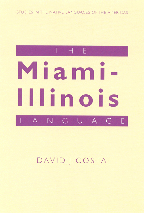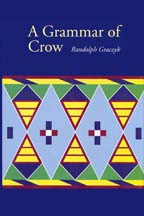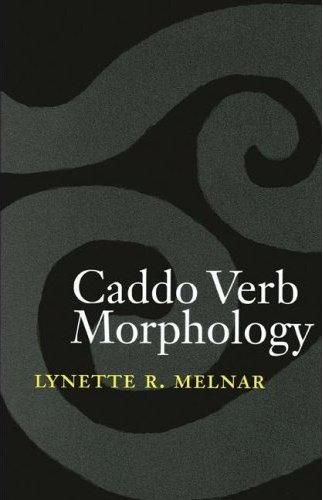For more information or to purchase any of the books in this series, please visit the University of Nebraska Press
The Miami-Illinois Language
David J. CostaCloth: 2003, xxi, 566
CIP.LC 2002114304 ISBN : 0-8032-1514-2
 The Miami-Illinois Language reconstructs the language spoken by the Miami and the Illinois Native Americans. During the latter half of the seventeenth century both Native communities lived in the region to the south of Lake Michigan in present-day Illinois and Indiana. The French and Indian War, followed in the late eighteenth and early nineteenth centuries by massive influxes of white settlers into the Ohio River Valley, proved disastrous for both Native groups. Reduced in number by warfare and disease, the Illinois (now called the Peorias) along with half of the Miamis relocated first to Kansas and then to northeast Oklahoma, while the other half of the Miamis remained in northern Indiana.
The Miami-Illinois Language reconstructs the language spoken by the Miami and the Illinois Native Americans. During the latter half of the seventeenth century both Native communities lived in the region to the south of Lake Michigan in present-day Illinois and Indiana. The French and Indian War, followed in the late eighteenth and early nineteenth centuries by massive influxes of white settlers into the Ohio River Valley, proved disastrous for both Native groups. Reduced in number by warfare and disease, the Illinois (now called the Peorias) along with half of the Miamis relocated first to Kansas and then to northeast Oklahoma, while the other half of the Miamis remained in northern Indiana.
The Miami and the Illinois Native Americans speak closely related dialects of a language of the Algonquian language family. Linguist David J. Costa reconstructs key elements of their language from available historical sources, close textual analysis of surviving stories, and comparison with related Algonquian languages. The result is the first overview of the Miami-Illinois language.
David J. Costa works as a professional linguist in Native language revitalization and lives in northern California.
A Grammar of Crow
Randolph GraczykCloth: 2007, 474
ISBN : 978-0-8032-2196-3
 Crow, a Siouan language spoken on the Crow Reservation in southeastern Montana, remains one of the most vital Native American languages, with several thousand speakers. A Grammar of Crow is the first detailed description of the Crow language in a contemporary linguistic framework. Randolph Graczyk draws on more than thirty-five years of daily contact with speakers of the language and his training as a linguist to offer an in-depth description and analysis of the crucial elements of the language, illustrated with numerous examples.
Crow, a Siouan language spoken on the Crow Reservation in southeastern Montana, remains one of the most vital Native American languages, with several thousand speakers. A Grammar of Crow is the first detailed description of the Crow language in a contemporary linguistic framework. Randolph Graczyk draws on more than thirty-five years of daily contact with speakers of the language and his training as a linguist to offer an in-depth description and analysis of the crucial elements of the language, illustrated with numerous examples.
The grammar is primarily descriptive, couched in terms of universal linguistic theory. It examines phonological, morphological, and syntactic features and treats the major phonological and morphological structures of Crow, paying considerable attention to the syntax of relative and subordinate clauses, noun incorporation, and various serial verb constructions. The switch reference system is also discussed in detail.
Randolph Graczyk has a PhD in linguistics from the University of Chicago. He is a Capuchin-Franciscan priest currently serving as pastor of St. Charles Parish on the Crow Reservation in Pryor, Montana.
Caddo Verb Morphology
Lynette R. MelnarCloth: 2004,
CIP.LC ISBN : 0-8032-3220-9
 At the time of European contact with Native communities, the Caddos (who call themselves the Hasinai) were accomplished traders living in the southern plains. Their communities occupied parts of present-day Texas, Arkansas, Louisiana, and Oklahoma. It was early Spanish explorers who named a part of this territory “Texas,” borrowing the Caddo word for "friend." Today there are approximately thirty-five hundred Caddos, most of whom live in Oklahoma. Their original language, which is related to the Plains languages-Pawnee, Arikara, Kitsai, and Wichita-is rapidly dying and is spoken only by a diminishing number of Caddo elders.
At the time of European contact with Native communities, the Caddos (who call themselves the Hasinai) were accomplished traders living in the southern plains. Their communities occupied parts of present-day Texas, Arkansas, Louisiana, and Oklahoma. It was early Spanish explorers who named a part of this territory “Texas,” borrowing the Caddo word for "friend." Today there are approximately thirty-five hundred Caddos, most of whom live in Oklahoma. Their original language, which is related to the Plains languages-Pawnee, Arikara, Kitsai, and Wichita-is rapidly dying and is spoken only by a diminishing number of Caddo elders.
Drawing on interviews with Caddo speakers, tapes made by earlier researchers, and written accounts, Lynette R. Melnar provides the first full-length overview and analysis of Caddo grammar. Because Caddo is an extremely complex language, Melnar's clear description will be important to linguists in general as well as to those specializing in Native languages.



